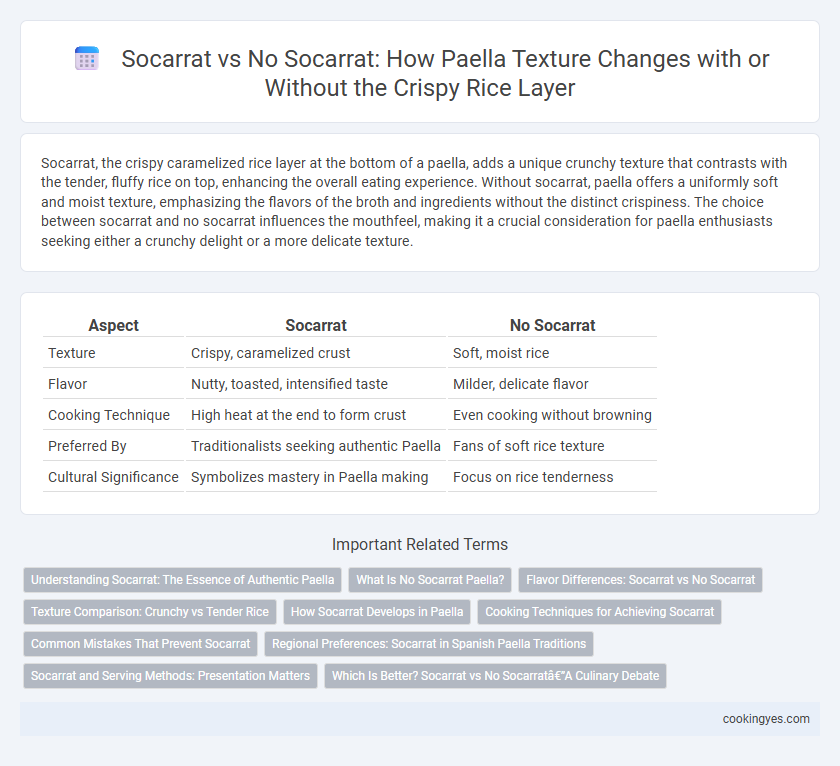Socarrat, the crispy caramelized rice layer at the bottom of a paella, adds a unique crunchy texture that contrasts with the tender, fluffy rice on top, enhancing the overall eating experience. Without socarrat, paella offers a uniformly soft and moist texture, emphasizing the flavors of the broth and ingredients without the distinct crispiness. The choice between socarrat and no socarrat influences the mouthfeel, making it a crucial consideration for paella enthusiasts seeking either a crunchy delight or a more delicate texture.
Table of Comparison
| Aspect | Socarrat | No Socarrat |
|---|---|---|
| Texture | Crispy, caramelized crust | Soft, moist rice |
| Flavor | Nutty, toasted, intensified taste | Milder, delicate flavor |
| Cooking Technique | High heat at the end to form crust | Even cooking without browning |
| Preferred By | Traditionalists seeking authentic Paella | Fans of soft rice texture |
| Cultural Significance | Symbolizes mastery in Paella making | Focus on rice tenderness |
Understanding Socarrat: The Essence of Authentic Paella
Socarrat is the crispy, caramelized layer of rice at the bottom of a traditional paella, prized for its rich, nutty flavor and contrasting texture that defines authentic Valencian paella. Achieving the perfect socarrat requires precise heat control to caramelize the starches without burning, creating a delicate crunch that enhances the overall eating experience. Paellas without socarrat tend to have a softer, more uniform texture, lacking the signature depth and complexity that this coveted crispy crust provides.
What Is No Socarrat Paella?
No socarrat paella lacks the signature crispy, caramelized crust formed at the bottom of the pan, resulting in a softer texture throughout the dish. This variation focuses on tender rice grains without the contrast of a crunchy layer, appealing to those who prefer a uniformly moist and smooth paella. The absence of socarrat emphasizes the flavors of the broth and ingredients without the toasted, slightly burnt notes typically associated with traditional paella.
Flavor Differences: Socarrat vs No Socarrat
Socarrat in paella creates a crispy, caramelized crust at the bottom that intensifies flavor with smoky, nutty notes contrasting the tender, moist rice above. Without socarrat, paella maintains a softer texture and milder taste, allowing the broth and ingredients' natural flavors to stand out without the added bitterness or crunch. This flavor difference significantly influences the overall sensory experience, with socarrat delivering depth and complexity, while no socarrat offers a subtler palate.
Texture Comparison: Crunchy vs Tender Rice
Socarrat creates a distinctive crunchy texture at the base of the paella, offering a contrast to the tender, moist rice above. This caramelized layer results from cooking the rice over high heat until it crisps, adding a nutty flavor and a satisfying bite. Without socarrat, the paella features uniformly tender grains, emphasizing creaminess and a softer mouthfeel throughout the dish.
How Socarrat Develops in Paella
Socarrat forms when the bottom layer of the paella rice crisps due to direct contact with high heat, creating a golden-brown, caramelized crust rich in flavor and texture. This process depends on controlling the cooking temperature and ensuring the paella is cooked evenly without stirring after liquid absorption. The Maillard reaction and slight toasting of the rice's surface contribute to the signature socarrat, distinguishing it from paella with a softer, non-crispy texture.
Cooking Techniques for Achieving Socarrat
Achieving the coveted socarrat in paella requires precise heat control and even distribution to create the signature crispy rice layer at the bottom. Using a wide, shallow paella pan over medium-high heat ensures the rice cooks evenly while allowing the socarrat to form without burning. Avoid stirring during the final minutes to let the bottom caramelize, resulting in the distinct textural contrast between socarrat and no socarrat paella.
Common Mistakes That Prevent Socarrat
Common mistakes that prevent achieving the perfect socarrat in paella include using excessive liquid, which inhibits the formation of the crispy rice layer, and stirring the rice too frequently, disrupting the crust development. Using low heat also limits socarrat creation, as sustained high heat is essential for caramelizing the rice at the bottom of the pan. Selecting the wrong type of rice, such as long-grain instead of traditional short-grain bomba rice, may result in uneven texture and hinder socarrat formation.
Regional Preferences: Socarrat in Spanish Paella Traditions
Socarrat is a prized feature in traditional Valencian paella, creating a crispy, caramelized crust at the bottom that adds a distinctive texture and rich, nutty flavor. In regions like Valencia and Alicante, the socarrat is celebrated as essential, symbolizing authenticity and expert cooking technique. Contrastingly, some northern Spanish regions prefer paellas without socarrat, favoring a softer texture that highlights the ingredients' freshness over the crunchy base.
Socarrat and Serving Methods: Presentation Matters
Socarrat, the prized crispy crust formed at the bottom of a well-cooked paella, delivers a rich, nutty flavor and contrasting texture that defines an authentic eating experience. Cooking techniques for achieving socarrat involve precise heat control and timing, ensuring the rice at the base caramelizes without burning. Serving paella traditionally on a wide, shallow pan enhances presentation and keeps the socarrat intact, allowing diners to appreciate both the tender top layer and the coveted crunchy bottom in every bite.
Which Is Better? Socarrat vs No Socarrat—A Culinary Debate
Socarrat, the coveted crispy rice layer at the bottom of a paella, offers a rich, smoky texture that amplifies flavor complexity and adds a satisfying crunch. In contrast, no socarrat results in a softer, more uniform rice texture, preserving the dish's moistness and highlighting the seafood and saffron nuances. Choosing between socarrat and no socarrat depends on personal preference and regional tradition, but culinary experts often favor socarrat for its distinctive texture contrast and enhanced taste depth.
Socarrat vs No Socarrat for Paella texture Infographic

 cookingyes.com
cookingyes.com